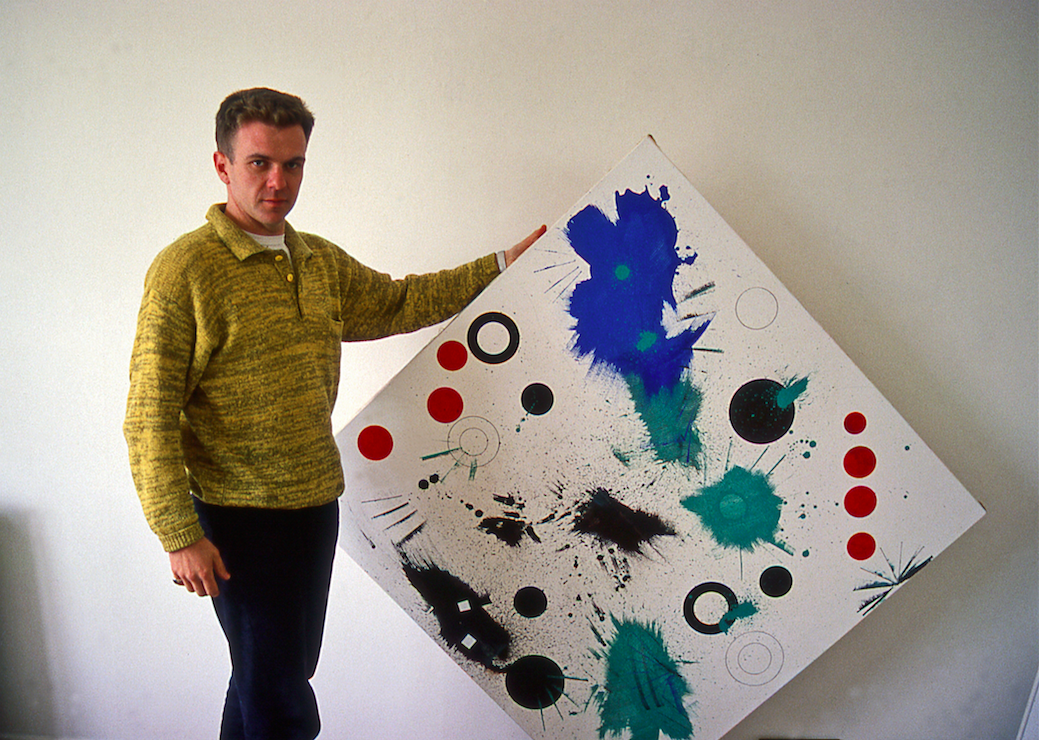Art and Australia 47, no. 2, Summer 2009.
‘The museum wants the artist timeless. It is waiting for the death. Only with the closure of death does the oeuvre completely and happily begin.’ So wrote Francis Pound in 1991, in a catalogue essay for Julian Dashper. His words returned to haunt us on 30 July 2009, when Dashper died at forty-nine, following a battle with cancer. Dashper is survived not only by his partner, artist Marie Shannon, and son Leo, but also by his work. Not so happily, his oeuvre may now ‘completely begin’.
In the mid-1980s, Dashper was a self-styled infant terrible. It was hard to know whether he was sincere or a prankster. His neo-expressionist paintings owed much to another Julian, but, by 1988, he had dropped Schnabel’s painterliness for a 1950s geometric mock-modernist look. For his Murals for a Contemporary House (1988), he hung absurdly boxy grid canvases on freestanding room partitions that were upholstered in a vile period fabric. The Murals were salvos pitched into a scene pondering the neglect of New Zealand’s pioneer abstractionists Milan Mrkusich and Gordon Walters, but no one knew whose side they were on, whether they were homage or piss-take. Dashper could be extraordinarily oblique. The Grey in Grey Lynn (1989)—a square canvas painted grey, punctuated with a white area, with the masking tape still left on—may have looked abstract, but those in the know were prompted to overlook its formality in favour of its references to Colin McCahon. But was Dashper really interested in McCahon’s achievement or distracted by side issues?
In addition to art legends, Dashper began exploring art’s other unacknowledged and overlooked supports. His stripe ‘paintings’, made from found printed canvas, were so devoid of incident that they seemed more like placeholders, making conspicuous the occasion of their exhibition. Sometimes, instead of paintings, Dashper presented sheets of slides, reminding us that the artwork is principally active through reproduction. Fetishising the business of promoting, packing, and installing art, he offered a banner advertising a show as the show, and displayed paintings wrapped in plastic and hung from chains. In museum projects, he took the opportunity to curate his works into conversations with works by famous artists, justifying his juxtapositions with contrived wall and catalogue texts. He made works out of empty frames—suggesting art was all frame. Observing how artists pin up their CVs in shows, he exhibited his CV as a work—his life’s work, so to speak. Placing art’s marginalia and supplements at the heart of his practice, he asked: Where does the work begin and end—at its edge, at its frame, its title, its label, the gallery, the catalogue, the myth?
Dashper was often rebuked for self-promotion. He may have been the first New Zealand artist to print his own business cards, and he pumped out publications for every second show, but his work was anti-heroic. It embodied a critique of the romantic-heroic ideal of the artist, typified in New Zealand by ‘visionaries’ such as McCahon, Philip Clairmont, and Tony Fomison. But, if Dashper presented the artist, by contrast, as part of a system, he was deeply romantic about that system and its trappings—he loved the life.
Although Dashper’s work was initially keyed to the New Zealand scene, from the mid-1990s he increasingly exhibited outside New Zealand, jettisoning local references and themes, producing works that could travel, physically and philosophically. With a pared-back language of generic motifs—frames, stripes, concentric circles, stars—he continued to scramble the logics of formal abstraction and conceptual art. Dashper may have started out Schnabelesque, but his work became hyper-refined; his installations precise, even dandified.
Despite the quality of Dashper’s immaculate later work, for me his primary achievement lies in his work of the late 1980s and early 1990s, which explored art’s marginalia while taking liberties with New Zealand art history. Here, he opened up a huge territory not only for New Zealand’s artists but also for its critics, curators, and art historians. He made New Zealand art history seem rich and pertinent, but also available for revision and mistreatment. Offering himself as an unfolding case study of a provincial artist wanting to make his mark locally and offshore, Dashper was one of a kind.
•
[IMAGE: Over the Net]
